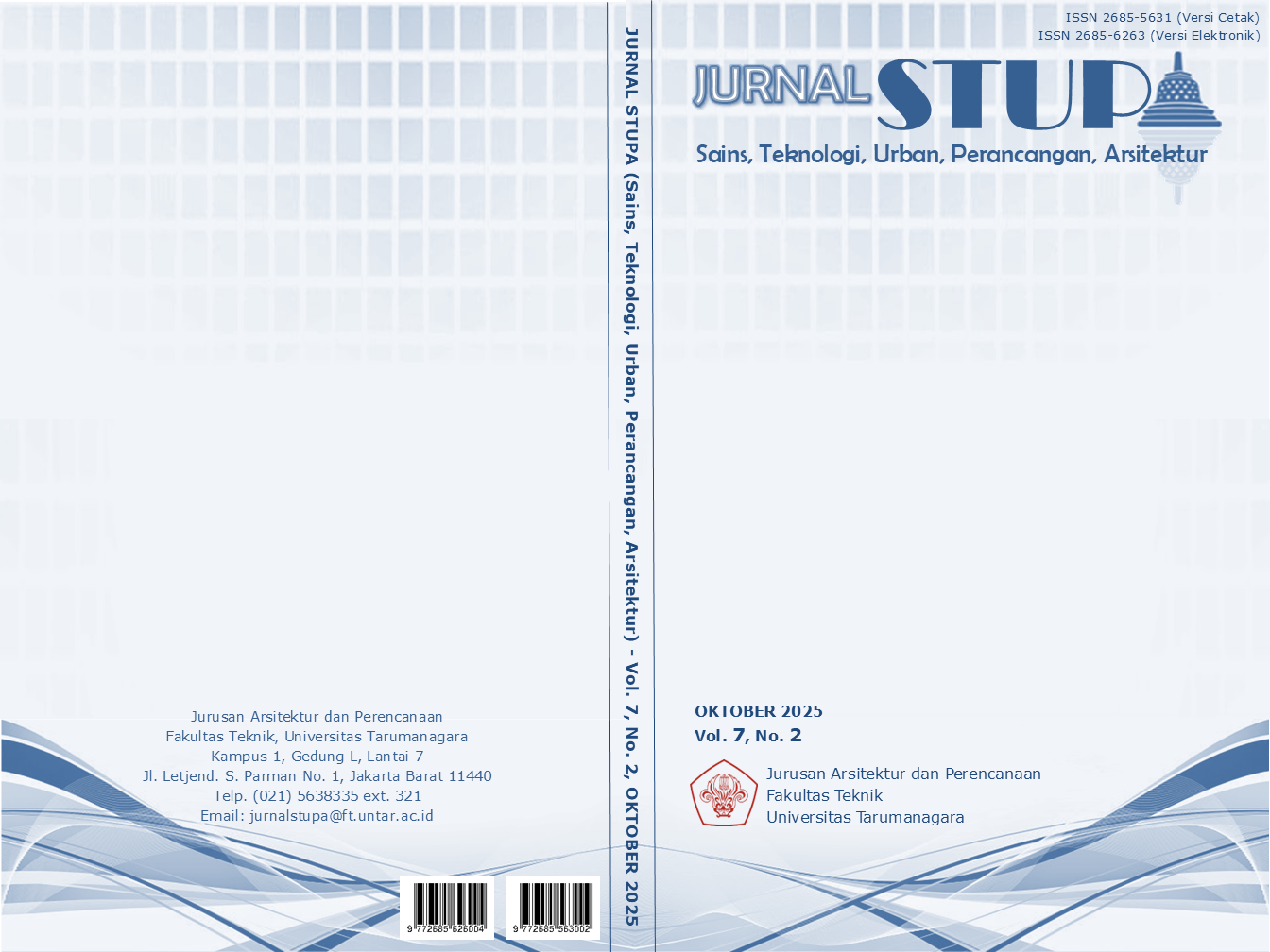PUSAT MEDITASI REGENERATIF BERBASIS ALAM DI SENTUL: INTEGRASI PEMULIHAN MENTAL DAN KETERHUBUNGAN EKOLOGIS
Main Article Content
Abstract
The rapid development of urban environments has led to various negative impacts on human well-being, particularly in the form of sensory overstimulation that contributes to a decline in quality of life. Individuals experiencing mental health issues such as stress, anxiety, and depression are increasingly vulnerable to dense, noisy urban settings that lack green spaces. This background highlights the need for an architectural approach that responds holistically to these challenges. This study aims to design a nature-based meditation center in the Sentul area using a regenerative architectural approach that is ecologically integrated. The main objective is to create a space for mental healing that also functions as a living, adaptive, and sustainable ecological system. The research adopts a qualitative-descriptive method, including literature review, site observation, and site analysis. The theoretical foundation encompasses regenerative architecture principles, bioclimatic design strategies, and psychological approaches related to nature-based therapy and meditation practices. The design focuses on incorporating natural elements such as sunlight, cross ventilation, organic materials, local vegetation, and contemplative circulation flows. The design outcome presents a meditation center that facilitates a calming multisensory experience through the integration of natural elements. The resulting space not only supports personal mental recovery but also functions as part of a regenerative ecological system, strengthening the relationship between humans and nature in a sustainable manner.
Keywords: ecological; meditation; mental health; nature; regenerative
Abstrak
Perkembangan lingkungan urban yang pesat telah menimbulkan berbagai dampak negatif terhadap kesejahteraan manusia, khususnya dalam bentuk overstimulasi sensorik yang berujung pada penurunan kualitas hidup. Individu yang mengalami gangguan kesehatan mental seperti stres, kecemasan, dan depresi semakin rentan terhadap kondisi lingkungan perkotaan yang padat, bising, dan minim ruang hijau. Latar belakang ini mendorong perlunya pendekatan arsitektur yang mampu merespons tantangan tersebut secara holistik. Penelitian ini bertujuan merancang sebuah pusat meditasi berbasis alam di kawasan Sentul dengan pendekatan arsitektur regeneratif yang terintegrasi secara ekologis. Tujuan utama dari perancangan ini adalah menciptakan ruang pemulihan mental yang sekaligus menjadi bagian dari sistem ekologis yang hidup, adaptif, dan berkelanjutan. Metode yang digunakan dalam penelitian ini adalah pendekatan kualitatif-deskriptif, yang mencakup studi literatur, observasi lapangan, dan analisis tapak. Landasan teoritis yang digunakan meliputi prinsip arsitektur regeneratif, desain bioklimatik, serta pendekatan psikologis dalam terapi berbasis alam dan praktik meditasi. Strategi desain difokuskan pada pemanfaatan elemen alami seperti pencahayaan matahari, ventilasi silang, material organik, vegetasi lokal, dan perancangan sirkulasi yang mendukung kontemplasi. Hasil perancangan menghasilkan sebuah pusat meditasi yang memfasilitasi pengalaman multisensorik yang menenangkan melalui integrasi elemen-elemen alami. Ruang yang dihasilkan tidak hanya mendukung pemulihan mental secara personal, tetapi juga berfungsi sebagai sistem ekologis yang regeneratif, memperkuat keterhubungan antara manusia dan alam secara berkelanjutan.
Article Details

This work is licensed under a Creative Commons Attribution-NonCommercial-ShareAlike 4.0 International License.
This work is licensed under a Jurnal Sains, Teknologi, Urban, Perancangan, Arsitektur/ STUPA Creative Commons Attribution-NonCommercial-ShareAlike 4.0 International LicenseReferences
Berman, M.G., Jonides, J. and Kaplan, S., (2012). The cognitive benefits of interacting with nature. Psychological Science, 19(12), pp.1207–1212.
Bratman, G. N., Anderson, C. B., Berman, M. G., Cochran, B., de Vries, S., Flanders, J., dan Daily, G. C. (2019). Nature and mental health: An ecosystem service perspective. Science Advances, 5(7), eaax0903.
Gesler, W. M. (1992). Therapeutic landscapes: Medical issues in light of the new cultural geography. Social Science dan Medicine, 34(7), 735–746.
Goyal, M., Singh, S., Sibinga, E.M.S., Gould, N.F., Rowland-Seymour, A., Sharma, R., Berger, Z., Sleicher, D., Maron, D.D., Shihab, H.M. and Ranasinghe, P.D., (2014). Meditation programs for psychological stress and well-being: A systematic review and meta-analysis. JAMA Internal Medicine, 174(3), pp.357–368.
Kaplan, R., dan Kaplan, S. (1989). The Experience of Nature: A Psychological Perspective. Cambridge: Cambridge University Press.
Kellert, S. R. (2005). Building for life: Designing and understanding the human-nature connection. Washington, DC: Island Press.
Mang, P., dan Reed, B. (2012). Designing from place: A regenerative framework and methodology. Building Research dan Information, 40(1), 23–38. https://doi.org/10.1080/09613218.2012.621341
Pallasmaa, J. (2005). The eyes of the skin: Architecture and the senses. Chichester: Wiley.
Pallasmaa, J. (2005). The eyes of the skin: Architecture and the senses. John Wiley dan Sons.
Rahardjo, A. (2023). Jakarta marketbeat reports. Cushman dan Wakefield.
Reed, B. (2007). Shifting from 'sustainability' to regeneration. Building Research dan Information, 35(6), 674–680. https://doi.org/10.1080/09613210701475753
Soga, M., dan Gaston, K. J. (2016). Extinction of experience: the loss of human–nature interactions. Frontiers in Ecology and the Environment, 14(2), 94–101.
Sternberg, E. M. (2009). Healing spaces: The science of place and well-being. Harvard University Press.
Sternberg, E. M. (2009). Healing spaces: The science of place and well-being. Harvard University Press.
Ulrich, R. S. (1984). View through a window may influence recovery from surgery. Science, 224(4647), 420–421.
Ulrich, R.S., Simons, R.F., Losito, B.D., Fiorito, E., Miles, M.A. and Zelson, M., (1991). Stress recovery during exposure to natural and urban environments. Journal of Environmental Psychology, 11(3), pp.201–230.
Williams, F. (2017). The nature fix: Why nature makes us happier, healthier, and more creative. W. W. Norton dan Company.
World Health Organization (WHO), (2022). Mental health: Anxiety disorders. [online] Available at: <https://www.who.int/news-room/fact-sheets/detail/mental-disorders> [Accessed 9 Jul. 2025].
World Health Organization. (2017). Depression and other common mental disorders: Global health estimates. Geneva: World Health Organization.



